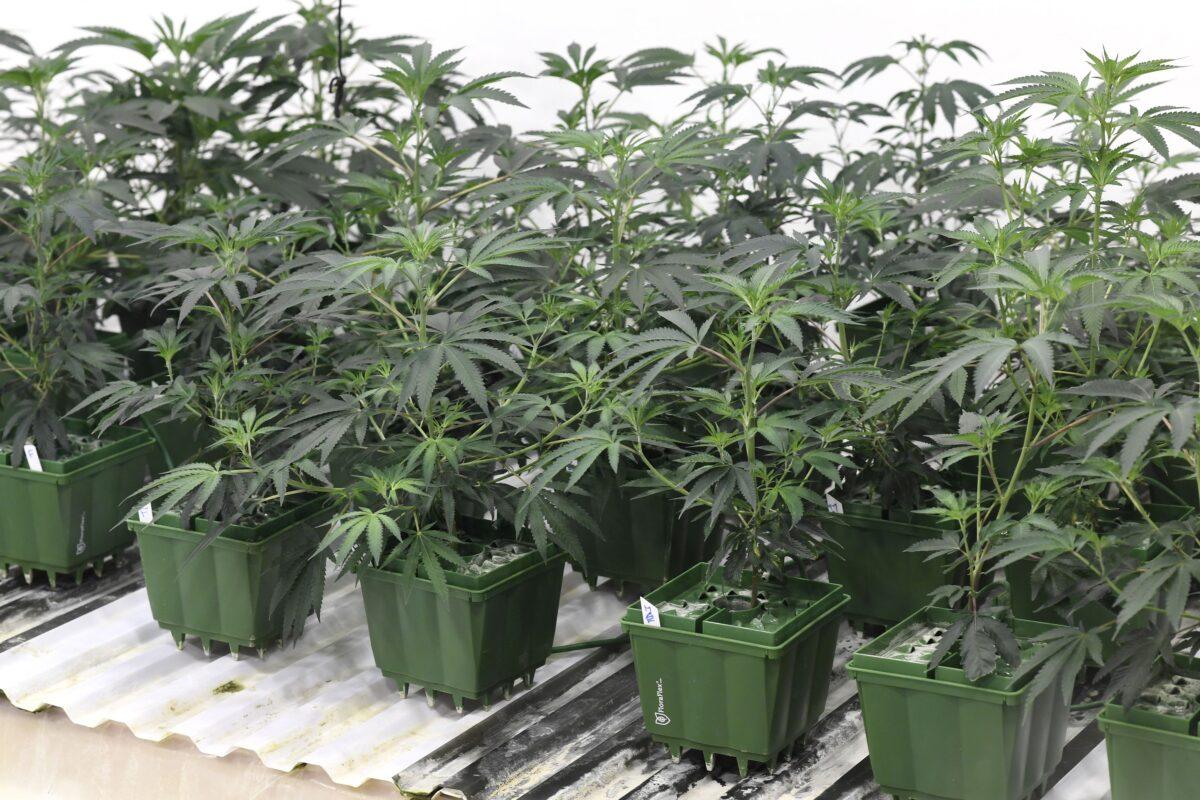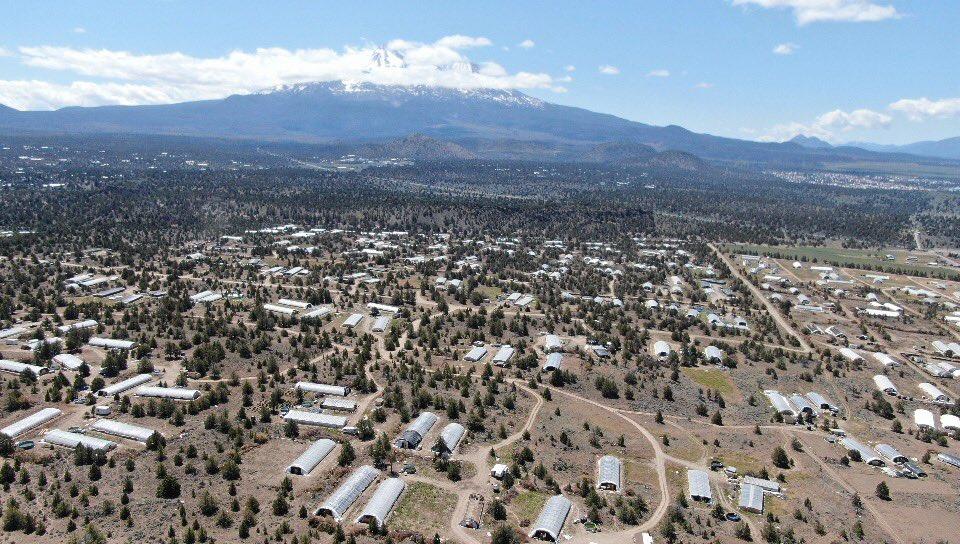California’s cannabis industry is in a free fall, with some municipalities in the northern part of the state making plans for significantly reduced tax revenues as a result of a collapse in wholesale prices.
Although fresh harvests were once selling for more than $4,000 per pound, bulk buyers are now shopping in the $300 to $500 range, according to experts, and some growers reported clearing out their crops for less than $200 per pound for fear of being stuck with product.
The price represents a sharp drop from recent years, according to industry insiders.
“It’s been a steady decline since we got here in 2010, but with the passage of Proposition 64 in 2016, prices accelerated downward quickly,” Rachel Greene, a longtime grower with experience in Mendocino and Humboldt counties’ cannabis programs, told The Epoch Times. “It was a combination of a lot of people getting in the game and the old corporate warfare model of operating at a loss to drown out the competition.”
Prop. 64—known as the Adult Use of Marijuana Act—was passed by voters and made the sale of recreational marijuana legal, creating the beginning of a regulatory framework to manage the industry.
Legitimate and illegitimate family businesses were severely affected by the plunge in profits and salability of a once easy-to-move commodity, according to farmers.

“I used to pay trimmers $300 to manicure each pound, and now I can’t even sell them for that,” a Mendocino County local who asked to be called Jack for fear of retaliation told The Epoch Times. “This was a business that benefited families all over the mountains here, and now there are growers and their helpers looking for work. Nobody knows what to do.”
Farmers are reporting a “perfect storm” of conditions, with inflation causing the cost of doing business to escalate significantly over the past two years, while the saturated market in California has left many growers with few options.
Lost Tax Revenues
Plummeting prices are affecting more than just the cannabis market, as rural regions of the state have become reliant on the industry supporting retailers and the taxes generated by increased cashflows in the area.The city of Ukiah, California, the county seat of Mendocino County, is preparing for an estimated $1 million drop in tax revenues, in part due to the weakened cannabis industry.
Revenues grew steadily year-over-year until experiencing a dip in 2022, with the busiest shopping season—the last three months of the year—resulting in a drop of nearly 10 percent compared with 2021, according to city records. However, the records don’t specify how much tax revenue was related to cannabis.
“This doesn’t make the impacts any less real, as we’re seeing the declines in numerous types of businesses, but they are difficult to measure,” Shannon Riley, deputy city manager for Ukiah, told The Epoch Times.
Garden supply sales were down by nearly 13 percent in Ukiah last year, and sales taxes collected overall were down by nearly 6 percent in 2022 compared with the year prior, according to HdL Companies—a firm providing audit, operations, and revenue management services to public agencies.
The state experienced 4 percent growth in overall sales tax revenues during the same period.
Compared with other cities in northern California facing tax revenue declines, Ukiah is uniquely positioned in the area, acting as a hub for surrounding communities, with medical facilities and shopping available for thousands of residents not living in the city, according to the deputy city manager.
“Ukiah is very well prepared for this type of adjustment and will continue to plow ahead with major infrastructure projects, street improvements, recreation programming and events, and more,” Riley said.
Other areas haven’t fared as well, with small towns in Northern California that once experienced a boom-and-bust moment with the loss of the logging industry now going through similar circumstances.

From Boom to Bust
Known as the Emerald Triangle for its renowned cannabis production, the counties of Mendocino, Humboldt, and Trinity grew in population and in economic activity following the passage of Proposition 215 in 1996, the first in the nation allowing for the plant’s medicinal use.While census data show modest growth for each county—approximately 11 percent for Mendocino and Humboldt and more than 20 percent for Trinity—in the 27 years since legalization, residents say those numbers don’t account for the actual number of people who moved in.
The discrepancy lies in the pattern of behavior for many who came to the region to set up their operations from other states but never registered to get California driver’s licenses and returned to their home state once the harvest was complete, according to farmers and local authorities.
From August to November, a sizable number of people traveled into the area in search of work as trimmers and laborers every year.
“It felt like the population doubled, and we’re a small community, so it’s easy to notice the newcomers,” Juan Aguilar of Ukiah told The Epoch Times. “For part of the year during grow season, and especially at harvest, we’d have huge crowds in the grocery stores, people all over town.”
Small businesses flourished in tiny towns up and down Highway 101 during the height of the Green Rush—the term used to describe the thousands of people that flocked to the region in search of opportunity from the industry—with a slew of restaurants and retailers opening and closing in a short time with the quick demise of the local cash cow.
Property prices in the area appear to be correlated with the price of cannabis, as evidenced by the number of transactions, price per acre of raw land, and home sales over the past two years, according to real estate brokers in Mendocino County.
Legal Versus Illegal Cannabis
While cannabis remains federally illegal, listed as a Schedule 1 narcotic with no medicinal value, 40 states and the District of Columbia have provisions allowing for personal medical consumption.Regulations preventing interstate distribution and limiting advertising hamper the ability of producers to reach potential target markets, according to industry analysts.
All legal cannabis grown in California is required by law to be sold in the state, and the 20 largest farms are capable of producing more than 2.6 million pounds—enough to supply the Golden State’s legal market—according to recent estimates from HdL.
More than 3,000 companies currently hold approximately 7,500 licenses, capable of growing 16 million pounds annually. With the state’s legal commercial market only capable of consuming 15 percent of this capacity, more than 70 percent of licensees are expected to experience net losses this year, based on HdL data.
More than 60 percent of cannabis grown in the state is unlicensed, according to law enforcement estimates, and their totals aren’t included in the above statistics, adding to the deeply oversaturated market.

Some of these illegal grows are “massive operations run by cartels,” a detective with decades of experience—who asked to remain anonymous for fear of his family’s safety—told The Epoch Times. “There are two families that control the majority of the production up here, and while we haven’t seen the violence that Mexico has, we know they’re here.”
With the emergence of legal cannabis in the state, it became easier for the cartels to grow in California instead of Mexico, and with no international border crossing needed to move their crops, profit margins increased and incentivized others to move their operations to Northern California, according to the detective.
“We’ve seen a steady influx of young workers from Sinaloa, Mexico, coming in over the last few years,” he said. “Things have changed in the community, to say the least, and for every illegal site we take down, three more pop up.”
Taxes at the county and state levels add to the financial burden for producers and consumers, according to experts.
“One of my neighbors’ invoices was for $55,000, and what he got back after county and state taxes and distribution fees was close to $6,000,” Greene said. “It was astonishing to see how little he walked away with, and it was disheartening for farmers like us and others that thought we were doing the right thing.”
Greene and others reported feeling let down by the policies designed to regulate the market.
“We thought the state of California was going to have our backs and help us succeed,” she said.
Two Assembly bills related to the dueling legal and illegal cannabis markets passed the Assembly Judiciary Committee on May 2, both attempting to give licensed operators legal recourse against unlicensed competitors.
These proposals come as sales across the state fell by 8.2 percent in 2022, to a total of $5.3 billion, the first drop since the recreational market opened in 2018, but this decline follows a 68 percent increase in 2020 and another 23 percent spike in 2021.
With market forces at play affecting producers and communities, the state’s coffers have benefited from the regulatory structure. As of the fourth quarter of 2022, California has collected $4.6 billion in cannabis tax revenue since 2018, according to the California Department of Tax and Fee Administration.





